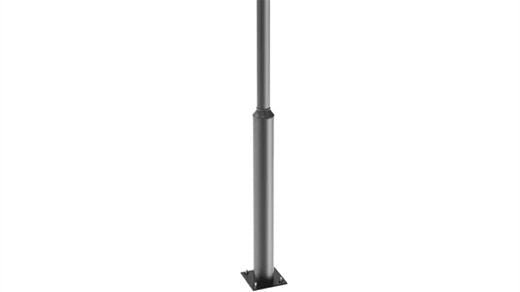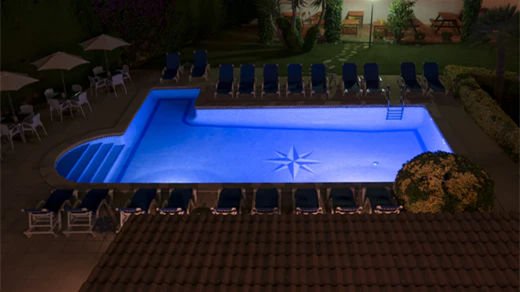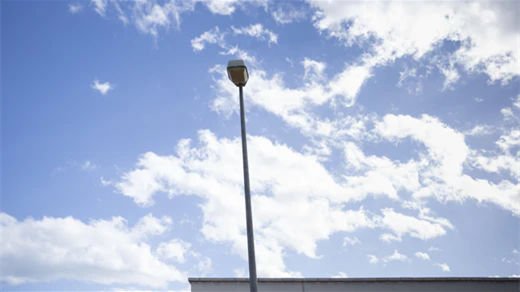2Street light poles often face challenges such as inclement weather conditions, including strong winds, which can compromise their stability and longevity. In this blog post, we will explore the significance of material selection for street light poles and discuss various techniques to reinforce them, ensuring their durability and resilience in adverse conditions.
Different Materials for Street Light Poles and Their Characteristics
Street light poles are available in a range of materials, each with unique attributes suited to specific requirements.
1. Aluminum
Aluminum is a lightweight and corrosion-resistant metal commonly used in street light poles. Its lightweight nature facilitates easier handling and installation, making it a preferred choice for settings where simplicity and efficiency are valued. Additionally, aluminum's corrosion resistance ensures longevity and minimal maintenance requirements, ideal for outdoor environments exposed to moisture and varying weather conditions. Moreover, aluminum's versatility allows for intricate designs and customization options to complement the aesthetic preferences of neighborhoods.

Copyright©bigshineled.com
2. Steel
Steel stands out as a robust and durable material for street light poles, prized for its exceptional strength and structural integrity. Steel poles offer unparalleled resistance to deformation and structural fatigue, ensuring reliable performance and longevity in challenging environments. The inherent strength of steel makes it well-suited for areas prone to vandalism or accidental damage, providing enhanced security and durability. Furthermore, steel's ability to withstand impacts and external forces makes it a preferred choice for applications where resilience is paramount.

Copyright©camerecastello.com
3. Fiberglass Reinforced Polymer (FRP)
Fiberglass reinforced polymer (FRP), also known as composite material, presents a modern alternative for street light poles, blending strength, durability, and corrosion resistance. FRP poles leverage the inherent properties of fiberglass, including high tensile strength and resistance to environmental degradation, to deliver lightweight yet robust structures. These poles offer excellent corrosion resistance, making them suitable for coastal or humid environments where traditional materials may corrode over time. Additionally, FRP poles exhibit inherent non-conductivity, ensuring safety near electrical installations. While less common than aluminum or steel, FRP poles offer unique advantages for specific applications where weight, corrosion resistance, and non-conductivity are paramount considerations.

Copyright©Fibroplastichem
Selecting the Most Durable Material for Street Light Poles
When choosing the most suitable material for street light poles, factors such as local climate conditions, budget constraints, and aesthetic considerations should be taken into account.
1. Aluminum
Advantages
- Lightweight: Aluminum poles are easy to handle and install, reducing labor costs and simplifying transportation logistics.
- Corrosion Resistance: Aluminum naturally forms a protective oxide layer, providing excellent resistance to corrosion and rust, particularly in outdoor environments.
- Aesthetic Versatility: Aluminum poles can be easily customized into various shapes and designs to complement the architectural style of neighborhoods.
- Low Maintenance: Aluminum requires minimal maintenance over its service life, saving on long-term upkeep costs.
Disadvantages
- Lower Strength: Compared to steel, aluminum has lower tensile and yield strength, which may result in less robust poles, particularly in areas prone to high winds or vandalism.
- Higher Cost: Aluminum can be more expensive than steel, potentially increasing upfront project costs.
2. Steel
Advantages
- Superior Strength: Steel poles offer unmatched structural integrity and resistance to deformation, making them ideal for applications requiring heavy-duty performance.
- Durability: Steel poles are highly durable and can withstand impacts, external forces, and harsh environmental conditions, ensuring long-term reliability.
- Cost-Effective: Despite potentially higher upfront costs compared to aluminum, steel poles offer excellent value over their extended service life.
- Security: Steel provides enhanced security against vandalism and accidental damage, making it suitable for high-traffic areas.
Disadvantages
- Weight: Steel poles are significantly heavier than aluminum or fiberglass, necessitating specialized equipment and additional labor for installation.
- Corrosion Risk: While steel can be galvanized or coated to enhance corrosion resistance, it may still be susceptible to rust over time, particularly in coastal or humid environments.
- Maintenance: Steel poles may require periodic maintenance, including repainting or rust treatment, to preserve their appearance and structural integrity.
3. Fiberglass Reinforced Polymer (FRP)
Advantages
- Lightweight and High Strength: FRP poles offer a unique combination of lightweight construction and high tensile strength, providing durability without the weight of steel.
- Corrosion Resistance: FRP is inherently resistant to corrosion, rust, and rot, making it ideal for outdoor applications in humid or corrosive environments.
- Non-Conductivity: FRP poles are non-conductive, reducing the risk of electrical hazards and enhancing safety near power lines or electrical installations.
- Minimal Maintenance: FRP requires minimal maintenance over its service life, reducing long-term upkeep costs.
Disadvantages
- Cost: FRP poles may have higher upfront costs compared to aluminum, although they offer long-term savings through reduced maintenance requirements.
- Aesthetic Limitations: While FRP can be molded into various shapes, it may not offer the same aesthetic versatility as aluminum or steel, limiting design options for street light poles.
In summary, the selection of the most durable material for street light poles depends on specific project requirements, including budget, environmental conditions, and aesthetic preferences. Aluminum offers lightweight construction and corrosion resistance but may lack the strength of steel. Steel provides unmatched durability and security but requires more extensive maintenance and may be heavier to install. FRP combines lightweight design with corrosion resistance and non-conductivity, making it an excellent alternative for applications where these properties are essential, albeit potentially at a higher upfront cost. By carefully evaluating the advantages and disadvantages of each material, homeowners and community planners can make informed decisions to ensure the longevity and reliability of street lighting infrastructure.

Methods to Enhance the Stability of Street Light Poles
To reinforce street light poles and withstand strong winds, several techniques can be employed.
1. Proper Installation
Ensuring proper installation of street light poles is essential for their stability and longevity. Poles should be securely anchored to a stable foundation, such as concrete footings, to prevent tilting or toppling during wind events.
2. Guy Wire Systems
Installing guy wire systems can provide additional support to street light poles, especially in areas prone to high winds. Tensioned cables or wires attached to the pole and anchored to the ground help distribute lateral forces, reducing the risk of pole failure.
3. Wind-Resistant Design Features
Incorporating wind-resistant design features into street light pole structures can enhance their stability and performance. Tapered or streamlined pole shapes reduce wind resistance and minimize the risk of swaying or vibration during gusty conditions.
Conclusion
By carefully selecting durable materials such as aluminum, steel, or composite, and implementing reinforcement techniques such as proper installation, guy wire systems, and wind-resistant design features, homeowners and community planners can ensure the stability and resilience of street light poles, creating safer and more visually appealing environments.


































Leave a comment
This site is protected by hCaptcha and the hCaptcha Privacy Policy and Terms of Service apply.